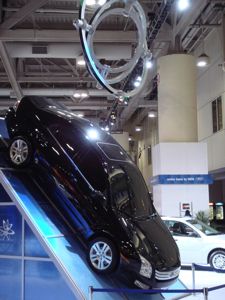January 15, 2010
Air Date: January 15, 2010
FULL SHOW
SEGMENTS
A New Electric Feel
View the page for this story
Capitol Hill’s bailout money is electrifying the Motor City. Car writer Jim Motavalli is at the Detroit Auto Show and tells host Jeff Young about the rollout of hybrids and plug-ins. (05:45)
Scientists Push Against EPA Decision
View the page for this story
The Environmental Protection Agency recently issued a new permit for a mountaintop removal coal mine in West Virginia. The mine will strip all of the vegetation and top soil from the mountain and fill the valley below with rubble and unwanted debris. Just three days after the permit was issued, the journal Science published a paper calling for a moratorium on mountaintop removal mining. Host Jeff Young talks with Margaret Palmer, lead author of the Science article, about why she and a dozen other scientists are willing to step into a political minefield. (06:20)
Goodbye to These Times
View the page for this story
Andrew Revkin says farewell to the environment beat at the New York Times newspaper, and hello to his new role as online communicator, author, and academic. He talks with host Jeff Young about ushering in a transformation in how the public understands climate change, and how human beings as a species might be finally learning to grow up. (07:55)
The Oyster is Their World
View the page for this story
Oyster reefs play a critical role in protecting our shorelines from storms and pollution but they are the most threatened marine habitat on the planet. We’re literally eating the oyster out of house and home and destroying reefs in the process. Living on Earth’s Bruce Gellerman traveled to Wellfleet, Massachusetts to learn how scientists are experimenting with new ways to restore oyster reefs. ()
The Language of Landscape
View the page for this story
Living on Earth continues its series exploring features of the American landscape. It’s based on the book “Home Ground: Language for an American Landscape,” edited by Barry Lopez and Debra Gwartney. In this installment, Jan DeBlieu defines the term “pocket beach.” ()
Ghost of the Mountain
View the page for this story
Author Sy Montgomery’s latest adventure took her to Mongolia to join a scientific expedition tracking snow leopards. Sy chronicles the search in her new children’s book called “Saving the Ghost of the Mountain: An Expedition Among Snow Leopards in Mongolia.” As she tells host Steve Curwood, the elusive cat is seldom seen but that doesn’t mean the snow leopard doesn’t leave any traces. ()
Brave and Dead
View the page for this story
In Mexico, hundreds of people are murdered every year for simply calling things the way they see them. So much is lost when these voices are silenced. Living on Earth's Ingrid Lobet pays tribute to two recently murdered men. ()
Show Credits and Funders
Show Transcript
HOST: Jeff Young
GUESTS: Jim Motavalli, Margaret Palmer, Randy Huffman, Andrew Revkin, Sy Montgomery
REPORTERS: Bruce Gellerman, Steve Curwood, Ingrid Lobet
[THEME: Boards Of Canada “Zoetrope” from “In A Beautiful Place Out In The Country” (Warp Records 2000)]
YOUNG: From Public Radio International - this is Living on Earth. I’m Jeff Young. Green cars take the spotlight at the Detroit Auto Show, where the buzz is all about electric-drive cars, and a lot is riding on battery research.
MOTAVALLI: We’re really gambling big on the battery. The lithium ion battery is the most affordable, the lightest, and the smallest in terms of packaging. Beyond that, I think we’re in the experimental realm.
YOUNG: The Motor City after the economic meltdown. Also, we’re eating the oyster out of house and home, destroying oyster reefs around the world.
GUEST 2: We weren’t surprised to discover that they were doing badly, but we were very surprised to discover how badly they were doing. They are actually the most endangered, the most threatened habitat type in the ocean.
YOUNG: Scientists look for ways to rebuild oyster reefs. Those stories and more this week on Living on Earth. Stick around.
[THEME: Boards Of Canada “Zoetrope” from “In A Beautiful Place Out In The Country” (Warp Records 2000)]
A New Electric Feel

Audi's new super-charged electric car, e-tron. (Photo: dchrisoh)
YOUNG: From the Jennifer and Ted Stanley Studios in Somerville, Massachusetts – this is Living on Earth. I’m Jeff Young. America’s most famous auto show kicked off in Detroit, the first since the bankruptcies and bailouts that shook the auto industry. Nearly every major automaker is showing green cars. Efficient – and often electric – rides are the big story.
Jim Motavalli’s there. He blogs on green cars for The New York Times, B-NET and others. Jim, so much has changed for carmakers, what’s the auto show like now?
MOTAVALLI: Well, I think you have to sort of take this show in context. On one level it’s a lot less glitzy than they tend to be, in the sense that there’s not as many big productions of new model introductions, there’s not as many spokes models on the floor as there generally is, usually that’s a the big thing.
On the other hand, the cars that are being debuted here are green cars that actually will go into production – that’s the big difference between now and a couple years ago. Generally, automakers have produced their green vehicles sort of as a showpiece thing, and it revolves on the show stand but is never actually produced.
YOUNG: But the cars you’re seeing are ones we might actually one day get to buy? That’s what you’re saying?
MOTAVALLI: Yes. Yeah, very much so, like for instance Audi showed off an E-tron, which is a second electric car prototype. Toyota had a very good, new hybrid car that’s smaller than the Prius. And Honda also had a new hybrid that is going into production, and it’s the CRZ, it’s a two-seater hybrid that gets 40 or so miles per gallon.

Honda touts the CR-Z as the world's first hybrid sport's car. (Photo by Jim Motavalli)
MOTAVALLI: Well, there’s no getting around the high cost of batteries. Any car that’s going to have batteries in it, in particular, the battery-only electric cars; they have a lot of battery in them and there’s no way you’re going to put that battery in there for less than ten thousand dollars your cost.
Therefore, you got to pass that on to the consumer. So even if you have a generally what you might call an economy car, it’s still going to cost 30 thousand, at least, and edging up into 40. So, 40 for the Volt is unfortunately not an inflated price, it probably is more like a break even or a lose money price for them.YOUNG: Sounds like there’s a lot riding not just on the bailout money itself, but on the government money that’s going into supporting battery manufacture?
MOTAVALLI: Yes, there’s a lot riding on that. We’re really gambling big on the battery. Every possible way of reducing the cost of that is being pursued, but it still doesn’t get you everywhere they need to go. The lithium ion battery is the most affordable, the lightest, and the smallest in terms of packaging. Beyond that, I think we’re in the experimental realm. And right now, we’re still looking at fairly expensive battery packs.
YOUNG: There’s a lot of buzz around Ford. The Ford Fusion hybrid just won car of the year, not green car, mind you, overall car of the year. I mean this is the company – F-O-R-D used to stand for Found On Road Dead; is this the same Ford company that used to be mocked not long ago?
MOTAVALLI: Well, I think you really have to give a lot of credit to Ford as having come back from the grave. They’re the only one of the big three that didn’t take a government buyout, and I think in some ways that’s helped their credibility and helped them move quicker in terms of getting new vehicles out.
And they’ve got all kinds of things – the new Ford Focus was debuted here, and I interviewed Bill Ford yesterday and I’ve always thought he was a very sincere guy in terms of his environmental convictions.YOUNG: Let’s hear a bit from your talk with Bill Ford, Jr. He says he wants Ford to sell the new Focus all around the world.
FORD: It will be the fuel economy and CO2 leader in every market in the world in which it participates.
MOTAVALLI: That’s a good world car, a very small car, a very fuel-efficient – I think that’s really smart. They’ll probably sell as many of them in China as they do in the U.S.
YOUNG: Of course, there is a lot of money heading into Michigan thanks to the Stimulus Bill and what not, but I’m guessing it’s still a fairly gloomy outlook in Detroit though?
MOTAVALLI: It’s gloomy. Coming in I decided to take public transportation, so I took a city bus and it wound its way through some of the devastation in Detroit and Inkster and Romulus and Dearborn, and you really get a sense of one of the most economically devastated places in the country. The state of Michigan, and Detroit in particular, really needs the auto industry to come back and to the extent that automakers are locating in Michigan. I think it’s a huge benefit and morale boost for the state.
YOUNG: And to what degree is the bailout responsible for the new green car direction that a lot these companies seem to be taking?
MOTAVALLI: I’m not sure that you could wholly say it was a result of that. I think the car companies are seeing the market go in that direction. The result is that by this time next year, if we’re talking next year, I think there are going to be a lot more green cars on the road than there is right now.
YOUNG: Our own Motor City madman, Jim Motavalli, thanks very much.
MOTAVALLI: Thank you.
[MUSIC: Medeski, Martin & Wood “First Light” from Radiolarians I (Indirecto 2008)]
Bill Ford speaks with Jim Motavalli about their new green Focus.
Scientists Push Against EPA Decision
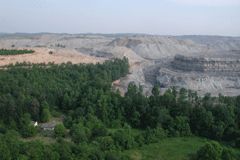
Mountain top removal mining strips all of the vegetation and topsoil off the top of a mountain in order to access the coal beneath it. (Photo: Vivian Stockman)
YOUNG: After putting dozens of mountaintop removal mining projects on hold, the U.S. Environmental Protection Agency recently approved a contentious permit for one of the mines. That means the Patriot Mining Company could soon begin to strip a mountain in Lincoln County, West Virginia, of its trees and soil. The seam of coal is then exposed with explosives.
[SOUND OF BLASTING AND FALLING DEBRIS]
YOUNG: The tons of rock and earth that once formed the top of the mountain will then be dumped into adjacent valleys. Patriot’s Hobet Mine – scaled back somewhat by EPA – could bury three miles of streams. Just days after EPA approved that mine, the journal Science published a paper on mountaintop removal that’s nothing short of a bombshell itself. University of Maryland biologist Margaret Palmer assembled a team of a dozen scientists with expertise in each area the mining harms – forests and flooding to water chemistry and public health. Dr. Palmer says impacts of the mining are pervasive and irreversible and attempts to regulate it are inadequate.
PALMER: A lot of streams are completely buried when they push the excess rock and material into adjacent valleys, are called “hollers” in that part of the country, and those streams are lost forever, they’re never uncovered and everything in them is killed. But in addition to that because the whole mountaintop has been flattened and all the trees removed you have dramatic changes in the hydrology – or the water flow – into the streams that remain below the mine sites.You get a lot more flooding and the frequency and the magnitude of those floods go up. Then additionally because the rock material that’s exposed to air and also rain after it’s been brought to the surface to reach the coal seams, it tends to leach a lot of chemicals that are very dangerous at the levels that the can occur in sites below mines. So, for example, things like manganese, iron, sulfate, and of particular concern, selenium.
YOUNG: Let me ask you though, why is selenium of particular concern?
PALMER: Well, selenium is a trace element that in small quantities is not dangerous, but when its elevated it causes serious problems. For example, fish exposed to levels of selenium that have been found in some streams and rivers below mine sites have seriously deformed spines, they have – some of them have two eyes on one side of the head. In general, their reproduction is reduced.
And higher levels of selenium have been found in some drinking water wells that people use in the region. So this is a major concern, and particularly because what our study really clearly showed was that as the amount of mining goes up in a watershed these various chemicals also go up linearly. The more and more mining that goes on, the more serious the water quality problems become.
YOUNG: So, what was your conclusion after looking at all these different impacts, having an expert in each of those individual impacts weigh in? What was the conclusion?
PALMER: Well, it was very clear and it was unanimous among all the authors that the impacts are so significant and they’re irreversible. Once the mountain’s gone, you know, it’s forever before it will come back, and the soils themselves won’t be back to previous levels for probably ten thousand years. There are streams lost, water quality impacts – our conclusion was that there really needs to be a halt on permits for mountaintop mining and it needs to happen quickly.
YOUNG: This is scientists stepping somewhat beyond the realm of strictly science into policy, isn’t it?
PALMER: Well, that’s true, but in many ways this is very much akin to the relationship between smoking and cancer – it is so obvious and so clear just like the Surgeon General warns people about smoking, we’re basically saying, hey, this needs to stop.
YOUNG: Now, in the same week that your paper was published in the journal Science, the U.S. EPA approved a mountaintop-removal mining permit that had been under review in West Virginia, the Hobet mine. Do you think the EPA has scientific justification now for approving mountaintop-removal mine permits?
PALMER: Oh no, they certainly do not and it is our hope that this synthesis we’ve put together – and much of the work was done by EPA’s very own scientists, some of the original work we brought in – we would hope that this would lead them to recognize that they need to quit giving out these permits and we were disheartened to hear about the Hobet permit.

Mountain top removal mining strips all of the vegetation and topsoil off the top of a mountain in order to access the coal beneath it. (Photo: Vivian Stockman)
PALMER: Well, if it continues the way it has been I would say that policy is not matching the science.
YOUNG: Dr. Margaret Palmer at the University of Maryland Center for Environmental Science, thanks for your time.
PALMER: Thank you, Jeff.
YOUNG: An EPA statement says the agency “look(s) forward to reviewing the details of this latest study and considering carefully its recommendations.” The EPA is still reviewing several mountaintop-removal permits, including one that would be the largest in West Virginia history. I spoke with the secretary of West Virginia’s Department of Environmental Protection, Randy Huffman.
HUFFMAN: Science is what it is. But the debate is going to take place over what is the acceptable amount of impact that society is willing to tolerate for the quality of life and standard of living. I don’t think that’s something that these other studies have taken into consideration. I don’t have the luxury of just looking at one side of it and drawing a line in the sand and saying I don’t have to consider those other things, because I do.
YOUNG: You can hear more of that interview and our extensive coverage of mountaintop removal at our website LOE dot org.
[MUSIC: Bill Frisell “Variation On A Theme (Tales from the Farside) from Ghost Town (Nonesuch Records 2000)]
Related links:
- Listen to a longer version of LOE's interview with Randy Huffman.
- West Virginia Department of Environmental Protection
- LOE Story: Living in the Shadow of Coal
- LOE Story: EPA Eyes Mountaintop Removal Mining
- LOE Story: Lost Mountain
- LOE Story: Hold on Coal
- LOE Story: Calculating Coal's Toll
- Margaret Palmer's Website
Goodbye to These Times
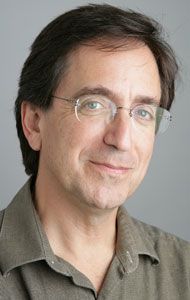
Andrew Revkin.
YOUNG: Just ahead – he wrote the climate news that was fit to print. A conversation with former New York Times reporter Andrew Revkin. Keep listening to Living on Earth!
YOUNG: It’s Living on Earth, I’m Jeff Young. If you read The New York Times, you might know the name Andrew Revkin. Revkin’s been a Times reporter since 1995, and over the years, his work on environmental issues like biodiversity and climate change has earned him a host of followers and a few passionate critics, like radio host Rush Limbaugh.
LIMBAUGH: This guy from The New York Times – if he really thinks that humanity is destroying the planet, that humanity is destroying the climate, that human beings in their natural existence are going to cause the extinction of life on earth, Andrew Revkin, Mr. Revkin, why don’t you just go kill yourself? And help the planet by dying.
YOUNG: Well, shortly after Limbaugh’s rant Andrew Revkin’s byline stopped appearing in the Times, but NOT because of Rush Limbaugh. Revkin has accepted a buyout offer at the Times, which like many big papers is struggling in the new media landscape. Revkin’s leaving daily reporting but he will continue his blog, Dot Earth. Mr. Revkin joins me now to talk about his tenure at the Times. Welcome to Living on Earth.
REVKIN: Good to be with you.
YOUNG: Just to clarify, you did not take Rush Limbaugh’s advice, we’re happy to report.
REVKIN: No, no, I am alive and well and remember, one of the things you learn in science is correlation is not necessarily causation.
YOUNG: [LAUGHS] But this is not too far off the mark from a lot of criticism that you take, particularly from what we would call hardcore skeptics or deniers of climate change issues.
REVKIN: Well, it’s a very heated discourse right now about climate because the consequences are so big, both environmental on one side, and according to the other side a huge economic disruption, a premature abandonment of fuels that have underpinned prosperity for 200 years. So, I’m kind of a convenient battering device for everybody.
YOUNG: I guess I could understand why you get such criticism from say, the skeptics, the deniers – why do you think you also get such heated criticism from folks who attack you from the other side?
REVKIN: Well, I guess it’s because in trying to just sort of suss out on the specific questions related to global warming – what we really know and don’t know – I don’t always paint a picture that matches the idea that human-driven climate change is a here and now unfolding catastrophe, that there’s no argument anymore.
YOUNG: And you disagree with that?
REVKIN: Well, the basics are crystal clear, as I’ve written for many, many years since the 80’s. There’s no dispute among people really focused on these questions that more CO2, more greenhouse gases, warmer world; warmer world, less ice; less ice, higher seas – this has been a mantra on Dot Earth and in my writing for years. But that doesn’t mean that there aren’t real disputes about certain aspects of this: health impacts, the pace of sea level rise, what hurricanes are going to do, the science has actually become more complicated. And there are some people who are so driven to get a piece of legislation through, or to seal the deal as the mantra was this past year on the treaty, that any talk of nuance or complexity is seen as a betrayal of some kind.
YOUNG: How was it covering Copenhagen as sort of the, uhhh, climax of your career at the Times there? Did it seem like a fitting way to go out?
REVKIN: There are some who would say, why are you getting out of journalism, or at least formal staff job at the newspaper right at this point when global warming has become such a momentous issue? And there’s been this impression periodically with global warming that this is the year. The last time was the late 80’s running up to the framework convention in 1992, then we had Kyoto the moment, and now we have Copenhagen the moment morphing into Mexico City the moment.
And having covered the human influence on climate since the mid-1980’s I had the privilege and the horror of getting a more realistic view of how this issue relates to the grander trends that are underway in human history right now. And that leads to very clear understanding the more you look at the moment that this is not a moment, that it’s a journey. You know, our relationship to energy is not going to be solved or transformed by any one president, any one administration, any one Congress, any one conclave in one capital or another. It’s an evolving process.
YOUNG: The time span of your time at the Times covers this period of great change in how climate change was perceived as an issue. It also covers a time period when we’ve had nothing short of a revolution in communications and journalism. How do those two things converge? How is the story of climate change being told and how is that changing?
REVKIN: Well, my sense is it’s amplified the edges of the discourse, in a way that’s not productive. What I try to do on Dot Earth is not – it’s not really a blog it’s interrogatory reportorial exercise where I’m asking questions, I’m laying out what I know. I’m not saying what to do and I’m not telling you what to think. But most of what you hear out there is at the edges. Catastrophe, hoax, catastrophe, hoax, and that for many people I think is not a useful way to get at this.
Even in deciding to leave the Times one of the downsides is abandoning to some extent that arena that’s kind of like the town plaza for ideas, which is the front page of a newspaper, or the homepage, increasingly. And this social networking media, Twitter, which I do a lot, I think also you’re kind of relying on your pre-orchestrated set of friends and contacts to shape what you’re – how you’re viewing stuff happening in the world, and that, too can be a potential problem.
But, cutting against that is that the old style of journalism, the old 20th century model, which was epitomized by someone who was hero of mine as a kid, Walter Cronkite – you know, ‘that’s the way it is’. You know, where you’re essentially given comfort food, sort of the intellectual equivalent of mac and cheese was the old nightly news cast where you got this comforting sense of that’s the way the world is, we all absorbed it communally. Now, it’s clear when you look at the problems that the world faces right now: economic, conflict and terrorism, and climate it’s a complicated – there aren’t easy answers. And anyone who’s telling you that’s the way it is, if they’re not including caveats, then they’re not really being true to the times.
YOUNG: Do you feel like you’ve spent your time covering the story of our times – is climate change the story of our times?
REVKIN: Climate change is not the story of our times. It’s a subset; it’s a symptom of the underlying growth spurt that we’re on as a species. And from many stand points this seems to be a unique juncture in our history.

Andrew Revkin.
It’s kind of like going through puberty, but at the level of a species. We’re at that juncture between the teen years where you didn’t really have to think much, you know, you just do little binges and not really think of the consequences. And now scientists are like the grownups in the room saying, hey, you know, if you keep this up, young man, you’re gonna hit a wall or go fly off a curb. And so as a species, as a community, a global community increasingly we’re facing this – this ugly reality that we’ve got to kind of grow up, and that’s the adventure and fun story of our time.
YOUNG: Andy Revkin leaving The New York Times but not leaving the realm of climate coverage, we’ll be hearing from you again, I’m sure. Thanks a lot for your time.
REVKIN: It’s my pleasure.
[MUSIC: Timewarp Inc “Phatmatrix Lounge” from Dub My Funky Groove (Timewarp Music 2005)]
Related links:
- Listen to an extended version of Jeff Young’s interview with Andrew Revkin.
- Check out Andrew Revkin’s blog, Dot Earth.
- For a critical view of Revkin’s climate coverage, check out the blog Climate Progress.
The Oyster is Their World
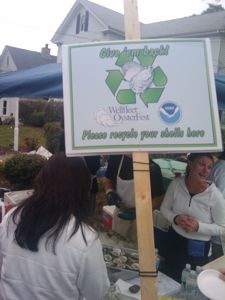
Oysterfest. (Photo: Bruce Gellerman)
YOUNG: Think oysters and you think food. Raw or Rockefeller, fried or on the halfshell. But if you think oysters are just good for food or making pearls, think again. The lowly mollusks are critical for the economic and ecologic health of our oceans, shores and bays.
Oyster reefs were once dominant features in the world’s estuaries. Today, scientists warn, they could be nearing extinction. Living on Earth’s Bruce Gellerman tells us scientists are now experimenting with artificial methods to restore this vital marine habitat. His story begins, where the oysters’ ends.
[SOUNDS OF RESTAURANT]
GELLERMAN: The Union Oyster House in downtown Boston is the oldest restaurant in continuous service in the United States. It’s here that the toothpick was first introduced in America, and John F. Kennedy regularly dined in booth 18 upstairs. But the real history goes to the oyster – this is the house that the bivalve made famous. In colonial America oysters were a cheap, abundant staple of the working class diet.
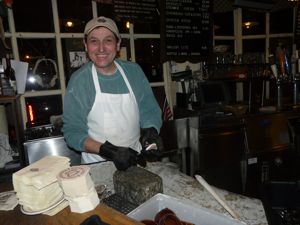
Anton Çhristen, oyster shucker and chef at the Union Oyster House in Boston. (Photo: Bruce Gellerman)
CHRISTEN: My name is Anton Christen. Originally I’m from Switzerland and what I do since about eight years I shuck oysters over here on the oyster bar.
GELLERMAN: How many oysters do you go through?
CHRISTEN: Usually we go through, probably on a Saturday, between two to three thousand pieces. I shuck a lot of oysters.
GELLERMAN: The oyster is Anton Christen’s world, and his weapon against the tough to open shell is a granite cobblestone. Christen grabs an oyster in his rubber gloved hand, inserts a blunt knife between the shells and taps the knife handle on the stone.
[SOUNDS OF CHRISTEN CRACKING OPEN OYSTER]
CHRISTEN: One little crack that’s the way we open.
GELLERMAN: Wow, that’s fast!
CHRISTEN: Thank you.
[SOUNDS OF TWO CRACKING TAPS]
CHRISTEN: Whenever I’m down in Wellfleet for the competition I’m bring my rock with me.
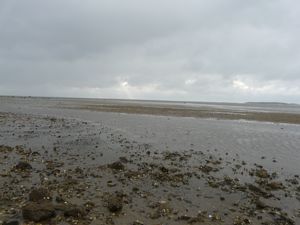
The harbor off Lieutenant Island. (Photo: Bruce Gellerman)
CHRISTEN: That’s not cheating, no.
[SOUNDS OF CRACKING]
GELLERMAN: Wellfleet, Massachusetts is where shuckers from around the world come to compete in the annual Cape Cod Classic.
[COMPETITION ANNOUNCER: “Three, two, one, shuck! Live championship shucking in lovely Massachusetts”]
GELLERMAN: This year, speed shucker William Chopper Young made Swiss cheese out of the competition.
[COMPETITION ANNOUNCER: “Ladies and gentleman, William Chopper Young!”]
GELLERMAN: When pilgrims first landed on Cape Cod, oyster reefs lined the shoreline and bays. Wellfleet harbor’s cold, clean, salty water, rich in plankton and micronutrients was the perfect place for oysters to spawn, and it still is.
PRESCOTT: Wellfleet is the location where the finest tasting oysters in the world are grown.
GELLERMAN: Bob Prescott can be forgiven if he’s a bit biased about Wellfleet’s oysters. He’s Director of the Wellfleet Bay Wildlife Sanctuary. Oysters are plentiful in Wellfleet, but these days as Prescott notes they’re not wild, they’re grown, cultivated in the briny bay.

Bob Prescott in the Welfleet lab. (Photo: Bruce Gellerman)
GELLERMAN: It’s the same story around the world: the wild oyster is history says University of Rhode Island Marine biologist Boze Hancock.
HANCOCK: We weren’t surprised to discover that they were doing badly, but we were very surprised to discover how badly they were doing.
GELLERMAN: Today, 95 percent of the oysters that are eaten are farm-raised. Diseases, parasites and invasive species have taken their toll, but people are the main problem. We’ve consumed the wild oyster nearly to extinction because when we throw away their shells we’re literally eating them out of house and home.
On the seabed, oyster shells build up over generations to form reefs. A single female oyster can lay a hundred million eggs year, but without the hard, shell reef to latch onto, the fertilized oyster larvae die. No oysters, no shells; no shells no reefs. Boze Hancock says we’re rapidly losing one of the world’s most important marine habitats.
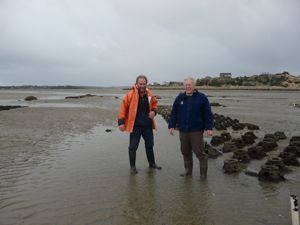
Marine biologist Boze Hancock (left) and Bob Prescott. (Photo: Bruce Gellerman)
GELLERMAN: Boze Hancock is coordinating a project with The Nature Conservancy and the National Oceanic and Atmospheric Administration to restore the nation’s oyster reefs from Alaska to the Gulf of Mexico, from the Chesapeake Bay to Maine. Scientists call oysters a keystone species. Besides being a source of food, the oyster is an ecosystem engineer that provides critical environmental services.
HANCOCK: A good, big oyster will filter up to 50 gallons a day. So if you get a reef that’s made up of million of these, we’re talking 50 million gallons a day. A lot of water.
GELLERMAN: In addition to filtering millions of tons of agricultural chemicals that runoff into bays and harbors, oyster reefs protect our coastlines from storm surges and create a rich biologically diverse habitat. Bob Prescott of the Wellfleet Bay Wildlife Sanctuary:
PRESCOTT: What were looking to do is recreate the reefs that were here so that the baby fish, baby crabs, birds and wildlife that are associated with those reefs can come back.
[SOUNDS OF WALKING ON TIDAL FLATS]
GELLERMAN: Building an oyster reef not as simple as it sounds. An icy wind blows off Lieutenant Island as Bob Prescott and Boze Hancock walk across the tidal flat off Wellfleet harbor where they’re experimenting with different structures to start oyster reefs.
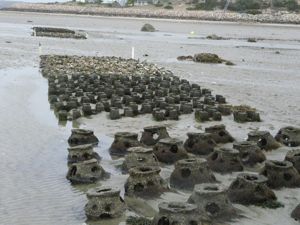
One of Welfleet’s experimental structures—reef balls—and oyster shells, or culch, piled behind them. (Photo: Bruce Gellerman)
[SOUNDS OF WALKING ON TIDAL FLATS]
GELLERMAN: The challenge: to design something low cost with the precise chemical composition and texture that tiny oysters will love to latch on to.
PRESCOTT: So you can start to see it from here. See all the rocks and then in between the rocks are all the treatments – there’s different treatments to see what the oysters are going to settle on the best.
GELLERMAN: Wellfleet’s tides move fast and far. We’re able to walk a few hundred yards on the mud flat when the tide is out to where volunteers have set up nine test beds spread out over two acres to test four different kinds of structures: Oyster mats, shells attached to biodegradable quilt material; Spat blocks, which are cement castles embedded with oyster shells; reef balls – round aggregates of concrete and shell; and culch, 50 pound mesh bags of clams and oyster shells saved from the past year’s oyster fest.

Bob Prescott looks for evidence of oysters in spat blocks. (Photo: Bruce Gellerman)
MARTINEZ: And then we need to flip over every shell and we count and measure all the oysters that we find.
GELLERMAN: Any idea which ones work best, which one of these treatments?
MARTINEZ: Umm, we haven’t analyzed anything yet, and as Bob said we haven’t finished, but the cultch is doing really well.
GELLERMAN: That’s these old shells here?
MARTINEZ: The old shells are great.
HANCOCK: What we’ve got here is the first year of settlement on these blocks.
GELLERMAN: Marine Biologist Boze Hancock:
HANCOCK: What we hope to see in years to come is that becomes solid oyster; you can’t see the cement underneath it. And depending on the strength of the settlement and rate of growth it could happen in one year it could happen in three years, but I’ve certainly seen in other states where these kinds of structures have become completely covered in oysters to the point where you can’t see what they’re on. And that happens quite quickly.
GELLERMAN: Which is hopeful news for the Chesapeake Bay in Virginia and Maryland where the oyster population has decline 99 percent in just 15 years. The oyster reef restoration project there recently received five million dollars in federal aid. Again, Bob Prescott of The Wellfleet Bay Wildlife Sanctuary:
PRESCOTT: Our goal is to recreate or restore those same kind of habitats that the Pilgrims found when they were here. Whether we can ever get back to the natural diversity for this whole harbor, that’s not as clear but we believe because a reef is a physical structure that we can get these oysters to rebuild those reefs. But we want to eat oyster reef habitat and there’s just no way around that, and we believe you can, but at the same time we have to leave this habitat somewhere. We have to harvest it at a lower enough level that it continues to exist in big chunks in this harbor.
GELLERMAN: Farm-raised oysters are fine eating, but home-grown oysters will never replace the vital ecosystem services that wild oysters provide, and hopefully the artificial reefs that scientists now plan to build. For Living on Earth, in Wellfleet, Massachusetts, I’m Bruce Gellerman.
[MUSIC: The Zydepunks “A Fistful Of Oysters from …..and the streets will flow with whisky (The Zydepunks 2005)]
(Video Courtesy of Karen Given of WBUR)
The Language of Landscape
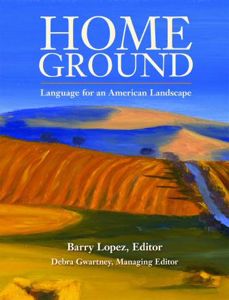
Home Ground: Language for an American Landscape, edited by Barry Lopez and Debra Gwartney. (Courtesy of Trinity University Press)
YOUNG: Coming up: the cat called “ghost of the mountain”.
MONTGOMERY: Here is this creature that no on ever sees but it’s able to live in the most extreme habitat in the world at heights that make it so difficult to breathe. They live in temperatures so cold that your tears will freeze on your face and your eyes. And they can become invisible right in front of your eyes.
YOUNG: An expedition in search of the Mongolian Snow Leopard. Just ahead on Living on Earth.
[MUSIC CONTINUES]
YOUNG: It's Living on Earth, I'm Jeff Young.
[HOME GROUND THEME: Daniel Lanois “O Marie” from Acadie (daniellanois.com 2000)]
YOUNG: The problem with being a beach lover is that so many others love beaches, too. But every once in a while the lucky hiker or boater will happen across one to call her own. That’s the subject of our latest excerpt from the book “Home Ground,” a collection of terms to describe our landscape.
Here’s Jan DeBlieu’s definition of a pocket beach.
DEBLIEU: Pocket Beach. A small gem, a pocket beach is a crescent of well-sorted sand tucked into a niche along a coastline. Where is occurs between headlands it is generally hidden from view and so all the more appealing. Pocket beaches are found along the coasts of Maine and Oregon, and in other places where the land falls precipitously into the sea. The term is synonymous with bay head beach and cove beach.
YOUNG: Jan DeBlieu’s most recent book is “Year of the Comet.” She lives on the beautiful beaches of North Carolina’s Outer Banks. The book “Home Ground” was compiled by Barry Lopez and Debra Gwartney.
[MUSIC: Anour Barhem: “Dance With Waves” from The Astounding Eyes Of Rita (ECM Records 2009)]
Related link:
Home Ground: Language for an American Landscape
Ghost of the Mountain

The stark mountains and landscape of Mongolia. (Photo: Nic Bishop ©)
YOUNG: Author Sy Montgomery’s interest in the natural world has taken her to the Amazon to swim with pink dolphins, and to Cambodia in search of the golden moon bear. Her latest adventure was in Mongolia. There she joined a scientist to track one of the most elusive cats: the snow leopard. Sy Montgomery sat down with Living on Earth’s Steve Curwood to talk about her new children’s book based on that trip, “Saving the Ghost of the Mountain: An Expedition Among Snow Leopards in Mongolia.”
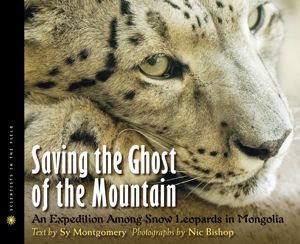
“Saving the Ghost of the Mountain: An Expedition Among Snow Leopards in Mongolia” by Sy Montgomery. (Photo: Nic Bishop. Reprinted by permission of Houghton Mifflin Harcourt Books for Children. All rights reserved.)
MONTGOMERY: Boy, well here was this extremely elusive cat – they call it “the ghost of the mountain” because it seems to have these supernatural powers. I mean here is this creature that no one ever sees, but it’s able to live in the most extreme habitat in the world at heights that make it so difficult to breathe. Humans really can’t go to the upper limits of the snow leopard’s territory.
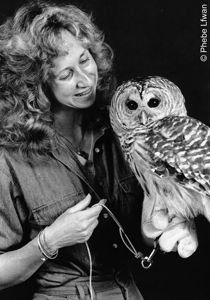
Author Sy Montgomery. (Reprinted by permission of Houghton Mifflin Harcourt Books for Children. All rights reserved.)
And most of the time you’re not going to be able to count every individual, of course not. Sometimes, they’re just too numerous to count. In this case, this is a critically endangered animal and knowing about how many there are and whether the population is rising or falling is absolutely crucial. So this expedition was to try to find out how many of them there are without being able to see them.
CURWOOD: So, tell me about the scientists that you went with on this expedition because I don’t think tour agencies take you looking for the snow leopard.
MONTGOMERY: No, they don’t. Tom McCarthy is the scientific director of the Snow Leopard Trust – his story is an interesting and inspiring one for kids because when he was growing up at first no one expected him to go to college or anything like that; he was one of the first in his family to go to college.
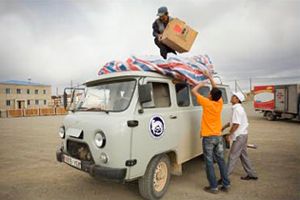
The van used to transport the team and their equipment throughout the expedition. (Photo: Nic Bishop ©)
CURWOOD: And so, off he goes and he gets to see some snow leopards, but I guess not terribly often, huh?
MONTGOMERY: Yeah, what happened was when he went into the field they were first starting to radio collar these animals. And to radio collar them you have to capture them. You capture them by setting out a baited trap, a leg hole trap that has been specially padded so that the animal’s leg isn’t hurt.
And it’s hard to catch these animals. When you catch them might be the last time you see them because even though you’ve got radio telemetry to track them – you know, the collar that sends a special signal that you can pick up and follow. Most of the time, he’d capture these animals and not see them for years or at all.

The stark mountains and landscape of Mongolia. (Photo: Nic Bishop ©)
So the two of them are perched on this ledge, one has binoculars, the other has a spotting scope, and from the way that the signal was coming in they know the animal is right in front of them. So, they put the scope up to their faces and the binoculars up to their faces they can’t see it. Well, the signals coming in showing that now it’s moving, it’s moving right in front of them.
Sometimes it’s hard to see an animal like this when it’s still, but when it’s moving you want to be able to see it. They’re looking through their scopes, their binoculars – they can’t see a thing. So, beep, beep, beep – they’re following the sound and they see from the sound the animal’s turning a corner and now it vanishes. And they never saw it. So, they think, how could this be?
Sometimes what happens is you get an echo. It’s a phenomenon that actually the signal is coming from somewhere else and it’s bouncing off your mountain, so they decided to descend to the valley where the animal had been, where they thought the animal had been and try to find some tracks. And they go down there, and there’s the tracks. And there’s a great, big, fresh poop sitting right there!
[CURWOOD LAUGHS]
MONTGOMERY: They’d never seen the animal!
CURWOOD: Now, Sy, I thought you might say that one reason why the kids are so interested in this particular story is that it has something that interests kids of really all ages: poop.
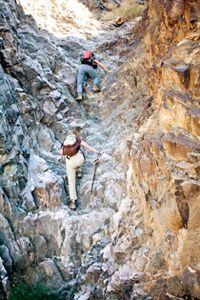
Sy Montgomery on one of the grueling climbs through the mountains in Mongolia. (Photo: Nic Bishop ©)
CURWOOD: You gather all this poop; you bring it back for analysis, that’s rather expensive. But then, in your book you say there’s a low cost way to this.
MONTGOMERY: Oh, yes. And this is something – this is pretty fabulous. This also might involve labs, but labs of different kind. Instead of laboratory, Labrador. Dogs, as you know, are extremely interested in poop and know a lot about it. And you can easily get a dog to recognize snow leopard poop versus wolf poop. I mean, they know this anyway, if you walk with your dog anywhere they’re looking, you know, like we check email, they’re checking “pee-mail” and “poop-mail”, and they know whose been where and how long ago, and they spend a long time thinking about this. So, it’s very easy to get your dog to tell you what it knows, you just have to train it in a way that you know what it’s trying to tell you. And so, they’re using these dogs to help them identify whose poop is whose.
CURWOOD: Much cheaper way to screen for snow leopards.
MONTGOMERY: That’s right, absolutely. You don’t have to do all the fancy spinning down of the DNA analysis. And when you compare it with the laboratory results, the dogs are extremely accurate.
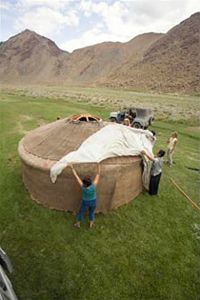
The ger, or yurt, the group assembled at each rest stop during their adventure. (Photo: Nic Bishop ©)
MONTGOMERY: Yes. That’s the way science really is. One reason that these books I think are important to write and get into kids’ hands – they want to see the grueling adventure, they want to go along, and for them it’s enough to have collected the scat that might turn out to be snow leopard, or might not.
For them, I think they find the adventure and the mystery, that’s all part of it – that’s real life, that’s real science. And sometimes it’s frustrating and sometimes it’s thrilling, but the great thing is the adventure continues, it keeps going on. Like loving somebody. And by the end of this book I hope that they love snow leopards enough to stay with that adventure and keep caring about these animals forever, even though they may never get to see one in the wild.
CURWOOD: Sy Montgomery’s new book is called “Saving the Ghost of the Mountain: An Expedition Among Snow Leopards in Mongolia”. She wrote the text, the pictures by her professional partner, Nick Bishop. Sy, thanks for taking the time to come by.
MONTGOMERY: What a pleasure, Steve. Thank you.
[MUSIC]
YOUNG: Living on Earth’s Steve Curwood interviewed Sy Montgomery. To see some photos from Sy’s expedition, go to our website LOE dot org.
[MUSIC: Grada “Snow Leopard” from Endeavour (Compass records 2005)]
Related links:
- Read excerpts from Sy’s Field Diary from her Mongolian Expedition.
- Snow Leopard Trust
Brave and Dead
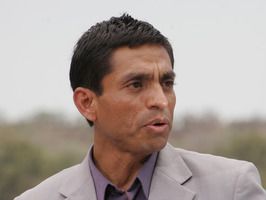
Reporter and host Jose "Pepe" Galindo of Radio Universidad focused much of his work on the environment.
YOUNG: Mexico is suffering an epidemic of violence, much of it related to the drug trade but some directed at those who work to protect the environment. Marcos Armendariz was a small town lawyer. Pepe Galindo was a journalist who covered the environment. They're just two of hundreds of dedicated professionals assassinated in Mexico in recent months. Living On Earth's Ingrid Lobet crossed paths with both these men and takes a moment to reflect on their loss and what it means for Mexico.
LOBET: When I visited the legal office of Marco Antonio Armendariz several months ago, I was struck by how humble it was. Key phone numbers scrawled on the side of a green file cabinet. A torn swivel chair. What Marcos felt confident he did have was a body of good law, Mexican law, and armed with it he was unafraid to go up against anyone in court. One case involved a small-town mayor, who was incensed at not receiving a customary bribe.
[ARMENDARIZ SPEAKING SPANISH]
VOICEOVER: I don't know, I imagine in the United States it's different. But here mayors have extraordinary powers.
LOBET: The mayor was making life difficult for a group of women Marcos was representing. They'd started their own electronics recycling business. The mayor refused to give the okay for the power company to turn the lights on in their plant.
[ARMENDARIZ SPEAKING SPANISH]
VOICEOVER: The mayor made them feel like he was police, judge and jury. He was sitting there like some cacique, like some duke from back in the Mexican Revolution.
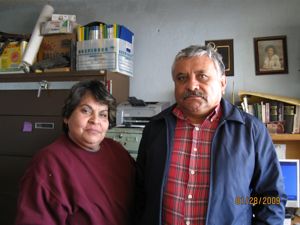
Marco Antonio Armendariz, legal advocate, in the office where he was murdered. With him is Vicki Ponce, one of many clients he represented pro bono. (Photo: Ingrid Lobet)
[ARMENDARIZ SPEAKING SPANISH]
VOICEOVER: What we're trying to do is put in our little grain of sand to fix Mexico.
We want to instill the idea of no bribes. Mexico, right now, is going nowhere. Bribery is everywhere. They say it's a tradition here, nearly the law, that it's always been that way. No, no, no! If we want to progress in Mexico, we have to go sweeping away all that rubble.
[ARMENDARIZ SPEAKING SPANISH]
LOBET: Reached by phone on his remote sheep ranch south of the border, Roberto Valenzuela described his friend.
VALENZUELA: He liked taking on big challenges, you know, challenges that nobody else wanted to do. He's left a big vacuum. We still can't believe that he's gone. He's irreplaceable.
LOBET: Marcos was working on a project, a dream, though he described it without saying the word "I". He wanted to create a free legal clinic in the small border town of Agua Prieta.
[ARMENDARIZ SPEAKING SPANISH]
VOICEOVER: We'd like to form some kind of an office of free attorneys advocating for the rights of children, of women and family. And also property, so they don't take away people's property. And I'm not saying we would never charge, but if a person who is poor comes in, how are you going to charge them? You just represent them, that's all.
[ARMENDARIZ SPEAKING SPANISH]
LOBET: On October 24th, 2009, Marcos was shot four times, sitting in that office chair, at extremely close range. There are no suspects and the ballistics investigation hasn't even concluded. Marcos' two grown daughters, one an attorney and one in law school, still want to open that legal clinic, somehow.
He also left behind a much younger, disabled daughter he was caring for. Farther south in the country, Jose Galindo Robles, who was known as Pepe, was a journalist with a fierce interest in environmental issues. He had recently received a master’s degree in environmental science and was a station director for the respected Radio Universidad outside Guadalajara. I met Pepe after he had finished a documentary about the contamination of one of Mexico's most important river systems, the Rio Lerma-Santiago.
[GALINDO REPORT IN SPANISH]
VOICEOVER: The environmental situation is alarming, not only the water pollution but there are secret chemical burial grounds here, and not far from the groundwater:
Ruben de Ireyo is a chemical engineer who used to work at one of the cyanide burial companies:
[GALINDO REPORT IN SPANISH]
VOICEOVER: It scares me to say this but it's true. These burial pits are on the companies' private property. They have dug these pits in their backyards to bury – to cover up – their crime. They buried 2,600 kilos a day for 28 years.
LOBET: The documentary won national recognition in Mexico in 2004. That same year Pepe was one of a small group of reporters who formed the Mexican Network of Environment Journalists. Here's another clip from that river report.
[GALINDO REPORT IN SPANISH]
VOICEOVER: The river is sometimes covered with foam; it can reach 60 feet high. The foam forms pillows and they float through the air. People who cross the bridge over the river do it running.
[WOMAN SPEAKING SPANISH]
VOICEOVER: People cross the bridge and be careful that the foam doesn't land on you! It hurts your skin. It damages the paint on your car. It's really something.
LOBET: Radio was Pepe's life, says his colleague Dr. Soraya Santana, a psychology professor at the University of Guadalajara.
[SANTANA SPEAKING SPANISH]
VOICEOVER: He always impressed on us the importance of this being a public University, that we owed our work to the people of the city, and that we needed to take our cues from the needs of the people, not from our own ideas of what constitutes "culture".

Reporter and host Jose "Pepe" Galindo of Radio Universidad focused much of his work on the environment.
[MUSIC: Lobet: E.S.T. “All The Beauty That She Left Behind” from Viaticum Platinum Edition (ACT Music 2005)]
YOUNG: Living on Earth is produced by the World Media Foundation. Our crew includes Bobby Bascomb, Eileen Bolinsky, Bruce Gellerman, Ingrid Lobet, Helen Palmer, Jessica Ilyse Smith, Ike Sriskandarajah, and Mitra Taj, with help from Sarah Calkins, Marilyn Govoni and Sammy Sousa. This week we welcome our new interns Emily Guerin and Bridget Macdonald. They’re both off to a running start! Jeff Turton is our technical director. Alison Lirish Dean composed our themes. Steve Curwood is our Executive Producer. You can find us anytime at LOE dot org. I’m Jeff Young. Thanks for listening.
Related links:
- Innovative Mexican Research Center on Crime
- Committee to Protect Journalists
- Knight Center for Journalism in the Americas
- One of Marcos Armendariz' pro bono projects
ANNOUNCER 1: Funding for Living On Earth comes from the National Science Foundation supporting coverage of emerging science. And Stonyfield farm, organic yogurt and smoothies. Stonyfield pays its farmers not to use artificial growth hormones on their cows. Details at Stonyfield dot com. Support also comes from you, our listeners. The Ford Foundation, The Town Creek Foundation, The Oak Foundation—supporting coverage of climate change and marine issues. The Bill and Melinda Gates foundation, dedicated to the idea that all people deserve the chance at a healthy and productive life. Information at Gates foundation dot org. And Pax World Mutual Funds, integrating environmental, social, and governance factors into investment analysis and decision making. On the web at Pax world dot com. Pax World for tomorrow.
ANNOUNCER 2: PRI – Public Radio International.
Living on Earth wants to hear from you!
Living on Earth
62 Calef Highway, Suite 212
Lee, NH 03861
Telephone: 617-287-4121
E-mail: comments@loe.org
Newsletter [Click here]
Donate to Living on Earth!
Living on Earth is an independent media program and relies entirely on contributions from listeners and institutions supporting public service. Please donate now to preserve an independent environmental voice.
NewsletterLiving on Earth offers a weekly delivery of the show's rundown to your mailbox. Sign up for our newsletter today!
 Sailors For The Sea: Be the change you want to sea.
Sailors For The Sea: Be the change you want to sea.
 The Grantham Foundation for the Protection of the Environment: Committed to protecting and improving the health of the global environment.
The Grantham Foundation for the Protection of the Environment: Committed to protecting and improving the health of the global environment.
 Contribute to Living on Earth and receive, as our gift to you, an archival print of one of Mark Seth Lender's extraordinary wildlife photographs. Follow the link to see Mark's current collection of photographs.
Contribute to Living on Earth and receive, as our gift to you, an archival print of one of Mark Seth Lender's extraordinary wildlife photographs. Follow the link to see Mark's current collection of photographs.
 Buy a signed copy of Mark Seth Lender's book Smeagull the Seagull & support Living on Earth
Buy a signed copy of Mark Seth Lender's book Smeagull the Seagull & support Living on Earth


